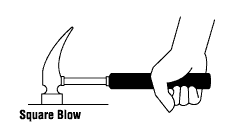Hand Tools - Hammers
On this page
What are some safety tips to know when using a hammer?
Back to topHammers and other striking tools are widely used and often abused. Hammers are made for specific purposes in various types and sizes and with striking surfaces of varying hardness. For example, hammers are used for general carpentry, framing, nail pulling, cabinet making, assembling furniture, upholstering, finishing, riveting, bending or shaping metal, striking masonry drills and steel chisels, and so on. Hammers are designed according to the intended purpose.
- Select a hammer that is comfortable for you, and that is the proper size and weight for the job. Misuse can cause the striking face to chip, possibly causing a serious injury.
- Choose a hammer with a striking face diameter approximately 12 mm (0.5 inches) larger than the face of the tool being struck (e.g., chisels, punches, wedges, etc.).
- Choose a hammer with a cushioned handle to protect you from vibration, impact, and squeezing pressure.
- Use hammers with electrically insulated handles for work on or around exposed energized parts. Always de-energize and lock out energized equipment when possible.
- Ensure that the head of the hammer is firmly attached to the handle.
- Replace loose, cracked or splintered handles.
- Keep the work area clear of debris.
- Discard any hammer with a mushroomed or chipped face or with cracks in the claw or eye sections.
- Wear safety glasses or goggles or a face shield (with safety glasses or goggles).
- Strike a hammer blow squarely with the striking face parallel to the surface being struck. Always avoid glancing blows and over and under strikes. (Hammers with bevelled faces are less likely to chip or spall.)
.gif)

- Look behind and above you before swinging the hammer. Keep enough clearance from fellow workers.
- Maintain a secure footing and keep a good balance while using a hammer.
.gif)
What should I avoid doing?
Back to top- Do not use a hammer with a loose or damaged handle.
- Do not use handles that are rough, cracked, broken, splintered, sharp-edged or loosely attached to the head.
- Do not use hammers with sharp edges, as they can cut off circulation in your finger after long periods of use.
- Do not use any hammerhead with dents, cracks, chips, mushrooming, or excessive wear.
- Do not use a hammer for any purpose for which it was not designed or intended.
- Do not use one hammer to strike another hammer, other hard metal objects, stones or concrete.
- Do not use awkward positions when using the hammer to prevent strains.
- Do not redress, grind, weld or reheat-treat a hammerhead.
- Do not strike with the side or cheek of the hammer.
.gif)
Refer to OSH Answers General Hand Tool Operation for more tips.
- Fact sheet confirmed current: 2023-12-14
- Fact sheet last revised: 2017-03-01
